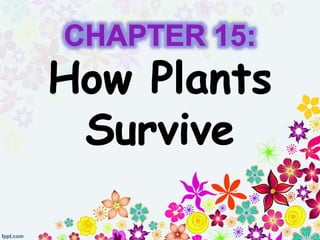
Chapter 5 : How Plants Survive
- 2. The is a hierarchy of structural levels just like the multicellular animals, the plant body is composed of an organ that is made up of tissues that is composed of group of cells.
- 4. ♠ MONOCOT ♣ Has only one (1) cotyledon. ♣ Its veins are usually PARALLEL. ♣ Its vascular bundles are complexly arranged. ♣ It has fibrous root system. ♣ Its floral parts usually in multiples of three (3).
- 5. ♠ DICOT ♣Have two (2) cotyledons. ♣Its veins are usually NET-LIKE ♣Its vascular bundles are arranged in rings. ♣Taproot is usually present. ♣Its floral parts are usually in multiples of five (5) or four (4).
- 6. ROOTS The root is an essential in a plant. Without it, a plant can’t get nutrients from the soil and the stem (containing the leaves and flowers) will not be able to grow upward.
- 7. ♠ STEM Stems is an organ of the plant that supports the leaves and of course, the flowers in the best position. It is the passageway of nutrients from the soil to the parts of the plant. Some plant species have modified stems that are especially suited to a particular habitat and environment. There are types of modified stems, the UNDERGROUND STEMS and AERIAL STEMS, but we will focus on UNDERGROUND STEMS.
- 8. ♠ STEM Underground stems, by being situated below the surface of the soil, protect themselves against unfavourable conditions of weather and the attack of animals, and serve as the store houses for reserve food and in vegetative propagation. The underground stems are of four types: .
- 9. Rhizome is a horizontal underground stem of some plant that sends out roots and shoots from its nodes. Gingers are RHIZOMES. ♠ Rhizomes
- 10. Bulbs are underground buds with the stem reduced to a small knob on which fleshy storage leaves are clustered. A good example of a bulb is an ONION ( ). ♠ Bulbs
- 11. Corms are upright underground fleshy stems covered by leaves reduced to dry, covering scales. ♠ Corms
- 12. Tubers are fleshy underground stems modified to store . The “ ” are the nodes with an axillary bud in each (the peel is periderm tissue). (kamote) is an example of Tubers. ♠ Tubers
- 13. ♠ LEAF Leaf is a flattened, green, lateral appendage that carries out the function of photosynthesis and transpiration. It is also responsible for taking in CO2 and releasing O and water vapour. CHLOROPHYLL is responsible for the leaf’s green colour.
- 14. ♠BRACTS Bracts are the leaves at the base of the flower.
- 15. Tendrils are modified special shoots with thin, modified stems. ♠ TENDRILS
- 16. Stolons are sometimes called RUNNERS; they are thin, above the ground, horizontal stems of indeterminate growth and long internodes that grow out from the parent plant. ♠ STOLONS
- 17. Plants organs are composed of three (3) tissue systems: ♣ Dermal ♣ Vascular ♣ Ground
- 18. It is the surface of the plant. It principally protects the inner tissues in the plant. ♠ Dermal
- 19. It is composed of XYLEM and PHLOEM, which function in the transport of water and dissolved substances. ♠ Vascular
- 20. There are 3 types of Ground tissues: ♣ PARENCHYMA ♣ COLLENCHYMA ♣ SCLERENCHYMA ♠ Ground
- 21. Parenchyma is located throughout the plant. It has a spherical shape. It is assigned for , , and . ♠ Parenchyma
- 22. Collenchyma is located beneath the epidermis in young stem and in leaf veins. It has elongated cells with unevenly thickened cell wall. Its function is to the flexible support system. ♠ Collenchyma
- 23. Sclerenchyma is located in the fibers in woods, bark, leaves, and stems. Its assigned or the structural support. ♠ Sclerenchyma
- 25. A plant’s growth and development, on its processes. Growth is irreversible increase in mass results from the cell division and cell expansion while development is the sum of all changes that progressively happens in an organism’s body.
- 26. are responsible for the division of new cells where zones are actively dividing cells can be found and where it allows the organisms to have indeterminate growth which insures that plant can grow throughout its life.
- 27. Cell division occurs solely in meristemic regions, while expansion may occur anywhere. There are three (3) types of zones. ♠ ZONES
- 28. It is the region of actively dividing cells and provides plant growth. Cells in this region grow longitudinally causing the root to grow longer. Region of mature primary tissues where active water and minerals are found.
- 29. Meristematic tissues are groups of young cells that undergo continuous state of division. These tissues are mostly found at the APICES of ROOT and SHOOT.
- 30. , their characteristics are: ♣They are living and thin walled. ♣Vacuoles are few and small in sizes ♣The cells contain dense protoplasm and conspicuous nuclei ♣The cells are SPHERICAL, OVAL or POLYGONAL in shape. ♣They do not store reserve food material and are in an active state of metabolism.
- 31. There are three different types of Meristems: ♣Promeristem or Primordial Meristem ♣Primary Meristem ♣Secondary Meristem
- 32. It is a group of meristematic cells of a growing organ. It is the early embryonic meristem from which other advanced meristems are derived. In a plant, it occupies a small area at the tip of the stem and root. ♠ PROMERISTEM or PRIMORDIAL MERISTEM
- 33. They are present under the Primordial Meristem at the shoot and root apices. ♠ PRIMARY MERISTEM
- 34. It is derived from primary permanent tissues which have the capacity of division. ♠ SECONDARY MERISTEM
